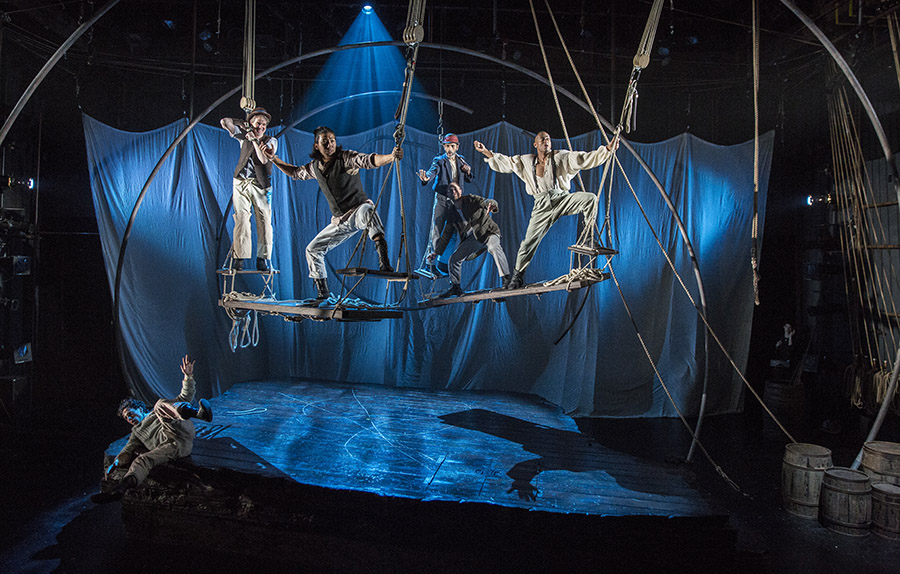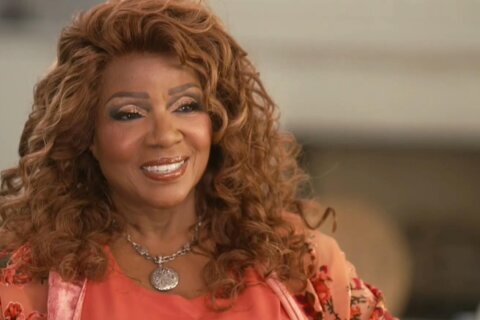WASHINGTON — “Call me Ishmael.” Are there any more famous opening words in all of literature than this narrator’s introduction to Captain Ahab’s sea quest?
“It’s an opening line we all know,” theater director David Catlin told WTOP. “If you know your Old Testament … Ishmael is the original outcast, so our narrator says, ‘I am an outcast.’ … So he goes to sea. He’s drawn to the water’s edge [which] is both calming but unsettling to know that beneath this beautiful, silvery surface reflecting Technicolor sunsets, lurks monsters both real and metaphoric.”
Now, for the next month, Ishmael (Jamie Abelson) will join Ahab (Christopher Donahue) aboard the Pequod to hunt the white whale within Arena Stage‘s fishbowl of “Moby Dick” now through Dec. 24.
“It’s breathtaking,” Catlin said. “This novel, there’s just so much in it that it feels impossible to stage. And I think that’s one of the reasons why we love it … because it’s impossible. Theater is one of those places where we [the] audience suspend our disbelief and believe in impossible things as a group.”
Long before adapting the 1851 book by Herman Melville — a novel that William Faulkner wished he had written — Catlin read the book as a procrastinating college student during an American lit class.
“I blew it off,” Catlin admitted. “I was a terrible student and I didn’t read it until [the final] week … I brewed plenty of espresso, ate some NoDoz … and in a caffeinated blur, I got through it faster than anything I’ve ever read in my life. … I loved it! My heart was pounding, probably from the caffeine, but also from the story! The sea adventure was just thrilling! I couldn’t turn the pages fast enough.”
Twenty years later, Catlin would adapt the book for Lookingglass Theatre Company in Chicago.
“An artistic colleague in Chicago approached me and said, ‘I’m adapting ‘Moby Dick’ myself. Do you want to be part of this collaborative process?'” Catlin said. “There were three of us and we made three different versions of ‘Moby Dick.’ Our theater company in Chicago, Lookingglass Theatre Company, we incorporate music, dance and visual storytelling that feels vibrant and even cinematic.”
Now, Lookingglass is partnering with Arena Stage, Alliance Theatre and South Coast Repertory for a unique production featuring trapeze and acrobatic work in a strobe-lit display of aerial storytelling.
“We incorporate elements of circus,” Catlin said. “We want audiences to feel like they’re in the story. … Really feeling it in their guts so it’s a visceral, muscular experience where you’re drawn to the edge of your seat. We literally have people flying overhead … We thought we can put actors in the air and make the air feel like the rigging of the ship … [or] feel like we’re now underwater, defying gravity.”

While the aerial rigging is elaborate, expect an expressionistic approach to the whale.
“We give you certain set and visual elements that lead you to believe this woman with an umbrella is an 80-ton whale,” Catlin said. “That’s really exciting as an audience member, to be with a group of people who suddenly believe that to be true. I think theater is one of the rare places that can happen.”
How does such complex staging work within the confines of Arena Stage?
“We had an audience member who saw a [rehearsal],” Catlin said. “She came up to me and said, ‘Was this theater designed for this play? It feels like it was designed for this play.’ There is something about that space that feels right for this play. It feels like you’re inside an aquarium with this giant whale.”
The setting is more than just flashy set dressing; it becomes a symbolic backdrop of images.
“There’s this prophecy that hangs around Ahab: ‘Hemp alone can kill him,'” Catlin said. “He believes that must mean the gallows, but you can’t be hung at sea, so he proceeds … presuming he’s safe [and] immortal because he’s away from the gallows. Unbeknownst to him, if he just looked up, the ship is covered with hemp and rigging and whale lines that are ultimately going to be his undoing.”
It’s here that Catlin revels in thematic symbolism.
“These ropes are ways we connect to things, to each other,” he said. “In the womb, we are connected to our mother by the umbilical cord. The lines on Ahab’s map connect them from where they are to where they wanna be. Queequeg’s tattoos were tattooed by this seer … who had a vision of the future, so these lines connect him to providence. Lines and rope become a very important metaphor.”
Catlin relates these lines to the Greek notion of the Three Fates — one who spins the thread of life, one who measures out a man’s thread and one who ultimately cuts it. In this production of “Moby Dick,” the Three Fates are played by three women: Kelley Abell, Cordelia Dewdney and Kasey Foster.
“This book is very much a masculine story,” Catlin said. “But if you think about it, ships are referred to with a feminine pronoun. They go out on the water, which I associate as feminine, even amniotic. … We think of Mother Nature and in particular whales. … ‘Thar she blows.’ So in our story, The Fates play the wives and widows they leave behind, they literally play the sea, the whales, nature herself.”
Beneath these more abstract concepts, there’s a far more primal force driving Ahab.
“When we think of Ahab, we think about a mad, monomaniac, crazy soul, how obsessed he is with this white whale,” Catlin said. “His idea is that Moby Dick represents evil incarnate. He seeks to rid the world of this evil whale. … So the crew rallies around it … It’s compelling what he’s selling … Unfortunately, that obsession, being consumed by something — he can’t let go of it and that becomes dangerous. … Even as we can see the negative side of Ahab, on some very human level, we get him.”
If you watch Ahab’s character arc closely, you’ll see how he changes at very distinct turning points.
“The end of Act One is Ahab rallying the crew to sign onto this noble quest, and somewhere toward the end of Act Two, Ahab begins to turn,” Catlin said. “He has a profane ritual where he baptizes this new harpoon, not in the name of the Father, but in the name of the devil. The crew, specifically Ishmael, become very aware that this thing that was once very noble … is becoming profane and bloody. … From that moment on, there’s a series of ominous portents that lead us to our doom.”
If Ahab’s obsessive quest sounds like Quint in “Jaws” (1975), you’re right. We likely wouldn’t have the second half of Steven Spielberg’s summer blockbuster if not for the blueprint of “Moby Dick,” nor would we have the music of Moby, nor Starbucks coffee, named after Ahab’s shipmate Starbuck.
Which brings us full circle to the coffee-infused college cram sesh when Catlin first read “Moby Dick.”
“You think you know this novel or you think you have an opinion about it or you think it’s boring and dull — it’s not!” Catlin insisted. “It is vibrant, it is vivid; the characters are fantastic, the story is just beautiful and I’m just very proud of this production … I promise you, you’re gonna love it.”
Click here for more details. Listen to the full conversation with “Moby Dick” director David Catlin below:








